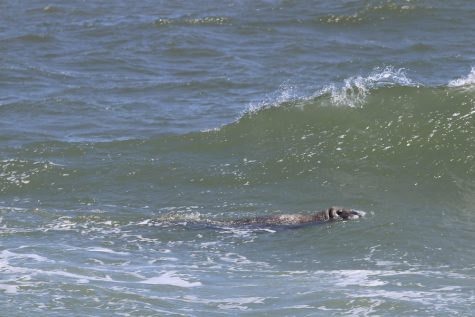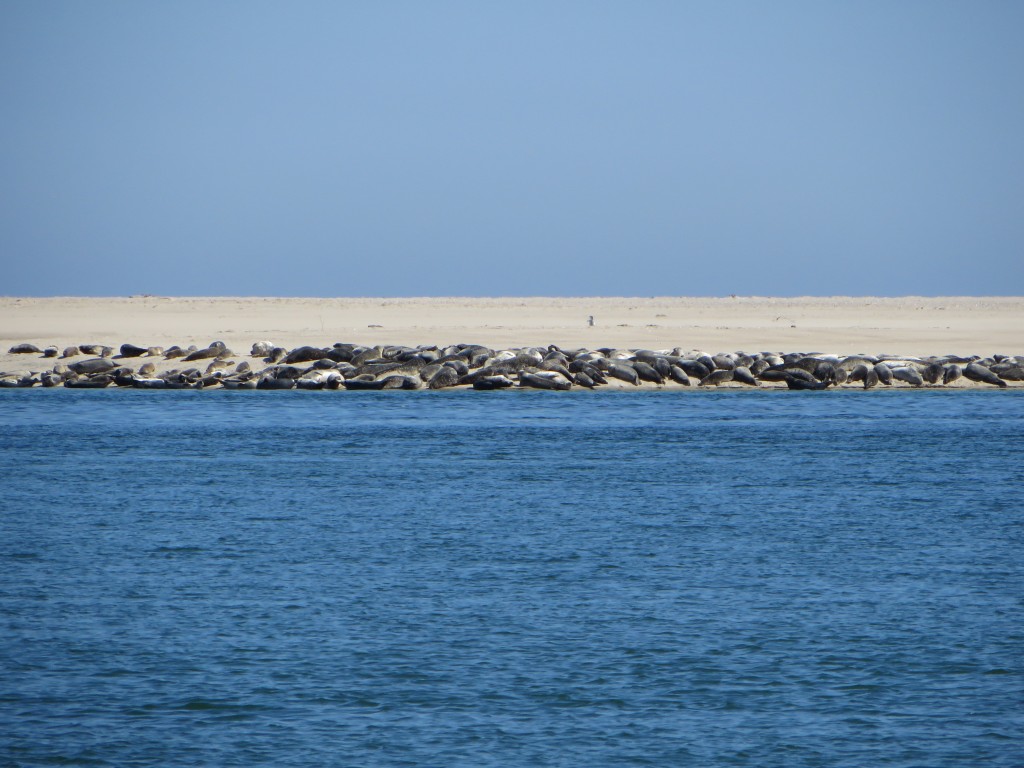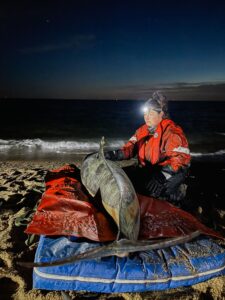 Over 30 species of seal, sea lion, and walrus dwell in the world’s waters, and a variety of seals inhabit the waters off Cape Cod. Yet, two species of seal call Cape Cod home throughout the year – harbor seals and gray seals. Both can be seen regularly, lounging or sunning themselves on the rocks, or resting in large numbers onshore in areas around the Cape, and can be found most commonly and in most abundance at Stellwagen Bank.
Over 30 species of seal, sea lion, and walrus dwell in the world’s waters, and a variety of seals inhabit the waters off Cape Cod. Yet, two species of seal call Cape Cod home throughout the year – harbor seals and gray seals. Both can be seen regularly, lounging or sunning themselves on the rocks, or resting in large numbers onshore in areas around the Cape, and can be found most commonly and in most abundance at Stellwagen Bank.
Harbor seals are relatively small (around 5 feet long), with a coat that varies somewhat with age, wetness and between individuals. Some pups are born with a light-colored, lanugo coat (fetal fur that most mammals shed before birth). The lanugo coat is shed within a few weeks of birth. Most seals, though, are born with an adult coat that darkens with age.
Harbor seals are carnivorous generalists. They eat small to medium-sized fishes, including cod, mackerel, and herring, as well as octopus, squid, and crustaceans. Shrimp are especially important to young harbor seal pups. Harbor seals will eat many different types of food, but the biggest part of their diets tends to be made up of just a few. Because harbor seals prey on commercially important species, they often come into conflict with fishermen.
Females in this area usually give birth in late spring and early summer. It is thought that females from Massachusetts migrate to quiet islands in New Hampshire and southern Maine to pup. Historically, harbor seals pupped in Massachusetts, and there are increasing sightings of very small pups here in May and June. Pups are able to swim within minutes after birth and can travel with the female while she hunts. On Stellwagen, small pups are often found treading water while waiting for mom to return from a dive.
Adults of both sexes are similar in appearance, with lighter undersides, brown to gray topsides and differing amounts of irregular spots throughout. Harbor seals’ front flippers have relatively small claws, and the claws of their hind flippers are tiny. At sea, they can be hard to spot. Only their heads are visible as they come up for air, their snouts are small and pointed, and they have a small but definite brow. If you have binoculars, you can spot ear openings just behind the eyes.
Gray seals, Halichoerus gypus, are the largest seal found in the area, with males growing to 8 feet and weighing over 900 pounds. Females are somewhat smaller, measuring 7 feet and weighing less than 600 pounds. Besides size, the sexes differ in a number of ways: males tend to be darker with few light spots, while females tend to be light with dark, irregular blotches. Young can be easily confused with harbor seals. With a head-on view, gray seals have wide-set nostrils that form a W, while harbor seals have close-set nostrils that form a small V. Sometimes called horseheads, gray seals of both sexes have broad, long snouts that become more pronounced, especially in males.
The gray seal feeds on a variety of different types of fish. They are great divers so if they can’t find enough food at the surface they will have no trouble going on a search for it. They will also consume herring and eels if they come across them in the water. Some of the larger ones have even been known to consume octopus and lobster. They tend to consume around 10 pounds of food per day when they feed as adults. They don’t feed daily though so that amount could be every other day or every third day. During the mating season they can fast for weeks at a time by living on the blubber that they have built up.
 Gray seals are endemic to the North Atlantic, ranging from the Baltic, Western Europe to Canada and Northeastern United States. In recent years, the number of gray seals in New England seems to have grown. It is not yet clear if the Canadian population is simply growing and moving south, or if there are other, environmental factors at work.
Gray seals are endemic to the North Atlantic, ranging from the Baltic, Western Europe to Canada and Northeastern United States. In recent years, the number of gray seals in New England seems to have grown. It is not yet clear if the Canadian population is simply growing and moving south, or if there are other, environmental factors at work.
Highly gregarious, gray seals are often found in large groups hauled out on quiet sand or rock beaches for rest and breeding. Females in this area, such as Monomoy Island in Nantucket Sound, give birth to one, white-coated pup from late December to mid-February. The pup is nursed intensively for about 15 to 20 days on an increasingly fatty milk. Females come into estrus about two weeks after weaning their pups. Males are highly competitive over access to groups of females on shore. After fertilization, the embryo stops development and “rests” for 3 to 4 months before development resumes (delayed implantation).
The multitude of seals that have been appearing on Cape Cod waters in recent years are beginning to affect the area’s economy in a number of ways. Researchers counted 68 great whites off Cape Cod in 2014. That number doubled to 140 in 2015, and there were over 160 sightings in 2019. But the hordes of seals are not only attracting sharks; they’re eating too many fish. Because seals are voracious eaters, an 800-pound male could consume up to 6 percent of his body weight each day. That’s 50 pounds of fish, including valuable species like cod and flounder. On the flipside, business is booming for the seal-watching and shark-watching tours industries.
According to the Center for Coastal Studies, three other species also migrate to New England Water in addition to the harp and gray seals, but in smaller numbers, are the harp, hooded and ring seals.
By CapeCod.com Staff
Content for this story was taken from coastalstudies.org and seas-world.com.
























